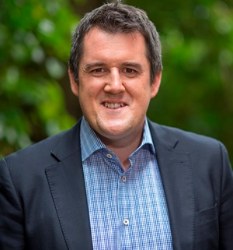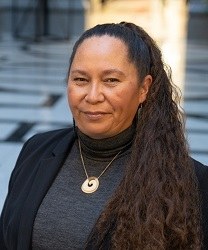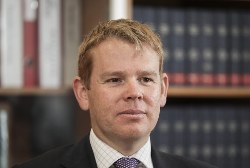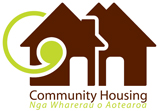ASMS President address to annual conference
Tena koutou, tena koutou, tena koutou, katoa. Welcome ASMS delegates, invited speakers, visitors from NZ and overseas, media, politicians and others to the 31st Annual conference of ASMS. I’m Murray Barclay, President of ASMS, and a gastroenterologist and clinical pharmacologist in Christchurch.
I would particularly like to welcome some special overseas visitors and speakers including Dr Andreas Botzlar, Vice President of the Marburger Bund and Armin Ehl, Managing Director of the Marburger Bund, which is the German doctors’ union. Ian Powell has maintained a strong relationship with the Marburger Bund over many years and it is a great sign of respect for Ian that we have these two prominent visitors from Germany here with us at Ian’s last conference. Likewise, we are fortunate to have Dr Rob Hendry, Chief Medical Officer for the Medical Protection Society based in London who will be talking to us tomorrow about current medico-legal issues, and I’d like to welcome Warwick Hough, Director of Workplace Relations, Legal Services & General Practice, Australian Medical Association (Federal), and Bernadette Mulholland of the South Australian Salaried Medical Officers’ Association. I also extend a warm welcome to Ellie Baxter who is to be the President of the NZ Medical Students Association for 2020, and other NZMA visitors.
All our annual conferences are important in different ways but there are several reasons why this one might stand out more than others. The first is that we are having the first change of Executive Director in our 30-year history. In June we celebrated the 30 year mark with a special anniversary conference. Last night we celebrated Ian Powell’s career-long contribution to ASMS and the public health system in New Zealand and we will continue this celebration and reflection in a special session later today. We also warmly welcome our new Executive Director as of January 1st Sarah Dalton and look forward to her contributions to ASMS. Ian has left a great legacy for Sarah to follow, and big shoes, but the Executive are already very confident that Sarah has the skills to do this and we are very much looking forward to the next phase of ASMS history.
Secondly, ASMS is about to enter our MECA negotiations with DHBs in early 2020 with the term of the current MECA expiring on 31 March. This is happening at a time when our hospital system appears to be on the edge of a dangerous precipice, more so than ever before. In fact, some would argue the public health system is already over the edge and plummeting. When we look at population growth, spiralling acute care demand and the very limited capacity we have in the New Zealand health system to deal with such growth, our system and staff are having to overperform or overwork on a daily basis – this cannot continue.
The theme of the conference is “Hospitals on the Edge” and there will be many examples and discussion of this over the next two days.
Progressive underinvestment in our health system over more than a decade has resulted in decaying buildings, worsening waiting lists and access to healthcare, and a “decaying” health workforce. That New Zealand now only spends 5.6% of GDP on the health of New Zealanders, when it is recognised internationally that greater than 10% is the optimal target, is a travesty.
Overwork and burnout are causing poor morale in many sectors of our Health Workforce.
Rates of sick leave are increasing steadily for all groups of healthcare workers, including hospital specialists. At Canterbury DHB sick leave rates amongst SMOs have almost doubled over 10 years. And it seems that virtually every health workforce union in New Zealand has had to go on strike in the past 18 months to achieve even minimal improvements in work conditions.
18 of our 20 DHBs have large deficits (this could now be all 20 DHBs in fact), totalling around $450 million, due to Ministerial underinvestment. This is leading to unbearable financial pressure that is passed down through levels of DHB management to workers, and ultimately to the public of New Zealand who are paying the price with their own health.
When the current coalition government came to power 2 years ago, there was much hope amongst health workers and voters that our health system may finally have some appropriate investment after the decade of retrenchment. The new Health Minister seemed intelligent and clearly aware of the issues that needed addressing.
He gave an impression that he was prepared to listen to health workers and wanted to really make a difference to health investment and well-being.
Within 1 year of coming into office however, it became obvious to us all that there were powers at play that were putting the Minister off his target of addressing the gross underinvestment in health.
One could speculate that political survival by demonstrating “fiscal responsibility” has a higher priority for this government than the health of New Zealanders (or the health of the Labour party is more important than the health of New Zealanders) or that Ministry staff may have been giving the Minister very poor advice for the past two years.
Whatever the reasons, the correction in health investment required has not happened, or at least not to anywhere near the extent required. To rub salt into the wound, this year a $7.5 billion budget surplus was announced. Meanwhile, we have witnessed lengthening waiting lists and sicker patients and there is no evidence of improvement in doctor well-being.
During this time also, the Health Ministry has forced DHBs to save money in hospital rebuilds by cramming hospital specialists into open-plan offices that have been shown to have negative outcomes on productivity and well-being. In a recent case at Waitemata DHB, SMO facilities have not been included at all in a new hospital design.
ASMS continues to show that we have a shortage of SMOs for our current workload in the order of 24%, that is we need roughly more than 1000 extra SMOs urgently to address patient load and doctor burnout.
We know that there has been net migration of doctors from New Zealand to Australia at a time when we most desperately need to retain our own doctors.
Tomorrow you will see data presented by BERL documenting one of the reasons for this migration to Australia. SMO salaries in Australia are approximately 67% higher in Australia compared to New Zealand.
Our highest salary step in New Zealand is lower than the lowest step in Australia. It appears there are about 1700 NZ-trained specialists in Australia.
As you know, our advanced training schemes are under a common umbrella for most specialties across the two countries and medical migration between the countries is simple, so if salaries are not competitive, it is obvious that doctors will flow to the country with the better conditions.
The World Medical Association data confirms this net flow from New Zealand to Australia and New Zealand has the highest percentage of foreign trained doctors in the world except for Israel.
The salary difference compared to Australia now needs to be addressed urgently starting with our next MECA negotiations to help stem the loss of doctors out of New Zealand and to compete in a competitive international market.
Working conditions also need to be competitive, which means we need more SMOs per head of population so that our conditions of work are not worse than in Australia.
For the past year ASMS has been offering a solution to the Minister of Health and DHBs to address fatigue, burnout and inappropriate staffing levels in the form of an accord. This would facilitate job sizing to match staffing to workload. The Minister has repeatedly taken a hands-off approach to the accord, and seems happy to leave senior medical staff with no mechanism to improve fatigue and burnout.
So you can start to see how important our MECA negotiations will be, starting in March next year. This is also an election year and so there is likely to be more than usual political pressure influencing the negotiations. Up until now the Minister of Health has piled enormous pressure onto the DHBs by underinvesting in health whilst at the same time avoiding political risk by not getting involved in solutions to the various industrial disputes in the past 18 months. It will be interesting to see whether he can maintain this stance during the SMO MECA negotiations and not offer help.
In addition to the BERL research looking at Australian salary comparisons, ASMS has contracted another very important piece of research in New Zealand this year. We have suspected for some time that there is a significant salary gap between male and female medical and dental specialists, and that this gap might be larger than could be explained by women taking time out to have family.
We therefore commissioned a project with Motu Economic and Public Policy Research in Wellington who specialise in combining and analysing large databases such as IRD and census data to answer important questions. They have performed an extensive analysis of New Zealand data and will present this tomorrow. The results are striking, showing indeed that there is a large and significant gap between salaries for male and female specialists, that cannot be fully explained by the different work patterns that result from having family.
Other substantial work by Charlotte Chambers this year suggests that this salary gap likely results from gender bias and gender schemas, or the subconscious expectations of both men and women for how men and women should behave.
Whatever the reason for the salary gap, it does exist, and this has major implications because a gap should not exist from a legal point of view. This is likely to be the start of a journey to correct the salary gap.
Lastly, you will see that we touch on the theme of Hospitals on the Edge repeatedly during this 2-day meeting. This is a critical point in the history of health care in New Zealand. Our country, and particularly our government, has an important choice to make. If poor staffing levels and hospital working conditions are not addressed urgently, the pain and suffering of New Zealanders will steadily worsen over the next few years and this will become increasingly difficult to claw back as fewer and fewer medical staff will want to work under these conditions. We can already see this happening in the UK National Health Service, where there are more than 100,000 vacancies in health that cannot be filled. We need to avoid this.
This all sounds rather negative and challenging and I would like to finish on a positive note. Under Ian Powell’s careful guidance, membership of ASMS is growing steadily, the organisation is larger and feels stronger than ever and we are in good shape to deal with the significant challenges upon us. Over the last 2 years the Executive has reviewed governance processes and documentation at ASMS and we feel more confident that we can better predict our finances and risks to the association and are better placed to deal with whatever comes our way.
You will see over the next 2 days that ASMS has become very proficient at accessing data that is important to the organisation and its members, information that can be used to improve working conditions for health workers, and so ultimately lead to better care for patients.
The New Zealand health system may be under enormous threat, and feels like it is about to go over the edge, but ASMS will be doing everything possible to try and avoid this.
ends


 Gordon Campbell: On bird flu, AUKUS entry fees and Cindy Lee
Gordon Campbell: On bird flu, AUKUS entry fees and Cindy Lee Family First: Just 1 In 6 Oppose ‘Three Strikes’ - Poll
Family First: Just 1 In 6 Oppose ‘Three Strikes’ - Poll Labour Party: Budget Blunder Shows Nicola Willis Could Cut Recovery Funding
Labour Party: Budget Blunder Shows Nicola Willis Could Cut Recovery Funding  Government: Urgent Changes To System Through First RMA Amendment Bill
Government: Urgent Changes To System Through First RMA Amendment Bill Peace Movement Aotearoa: Global Military Spending Increase Threatens Humanity And The Planet
Peace Movement Aotearoa: Global Military Spending Increase Threatens Humanity And The Planet Government: To Introduce Revised Three Strikes Law
Government: To Introduce Revised Three Strikes Law Labour Party: Environmental Protection Vital, Not ‘Onerous’
Labour Party: Environmental Protection Vital, Not ‘Onerous’


